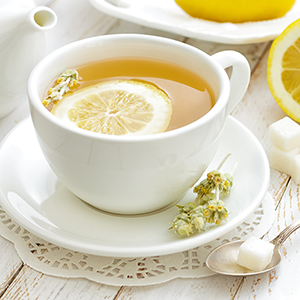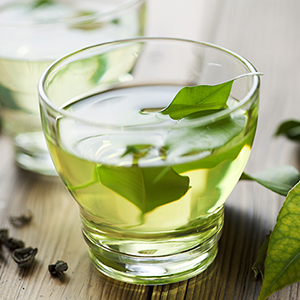Tea: Glorious and Soothing

Tea is far more than hot water and a few leaves or a steeping tea bag. With more than 700 billion cups consumed worldwide each year, tea is also an art form, a way of living and a legend in its own right.
The inventor
It all started in Asia 2737 years before Jesus Christ. The inventor of tea may well have been a Chinese emperor who drank only boiled water. The story goes that one day, Chen Nung was dozing in the shade of a wild tea plant when a breeze blew a few tea leaves into his cup. Waking, he drank the resulting brew and felt perked up. Christened the "royal drink ", the "miracle" tea was thought to provide the energy needed for meditation, leading to world conquest.
Around the world
From Asia, transported along caravan routes, tea gained popularity throughout Persia, then India. Packaged in bricks for easier movement, it covered Mongolia, arrived in Tibet, winning over the Middle East, ranking with vodka as the drink of choice in Russia. Tea found its way into the salons of Louis XIV where the Marchioness de Sévigné noted in her letters that drinkers were adding "a drop of milk." Swayed by Queen Victoria who adored it, the British made tea their national drink. To this day everyone still makes a good cup of tea.
Tea Pleasures...

Did you know?
There are more than five hundred blends coming from all parts of the world. Green teas, whites, semi-fermented, blacks or scented. China, India and Sri Lanka are the three largest producers of tea. Others include Taiwan, Indonesia and Japan, where a Buddhist monk made tea in the 9th century. He brought plants back from China that he cultivated at the foot of the sacred Hirizan Mountain.
Japanese philosophy
The tea ceremony was invented here. Tea is far more than a drink among the Japanese—it is a philosophy that follows precise rules, handed down from generation to generation. Called cha-no-yu, it defines a veritable art in entertaining. Prescribed gestures, mutual salutations, kneeling, all are performed during the four hours required to complete the tea ceremony.
How and When to Take Tea?
From breakfast to evening, while enjoying the noon meal, each country has its own customs for drinking tea. Here's an overview:
In England
Early morning tea is taken clear on waking, often in bed, to start the day. At breakfast, more tea is consumed, hot and strong, with a little milk and sugar added to mitigate the tannin, accompanied by porridge, boiled eggs and even fish. Assam from Thailand or Ceylon, or Darjeeling, are favoured, though the blend changes depending on the hour of the day. Earl Grey or Lapsang is favoured at noon or during the afternoon. Tea is consumed again in the evening. Tea is served in a silver teapot and savoured in a porcelain cup with little cucumber, tomato or cream cheese sandwiches and watercress, a slice of lemon, scones and buttered crumpets.
In Germany
Germany discovered tea long before the England. In the 18th century, it replaced soup in the morning and was taken three or four times a day. Even today, Germans drink as much tea as the British and two or three times more than the French. Light cream is sometimes added to herbal tea. Iced tea is popular in summer.
In Russia
The great writers Tolstoy, Pushkin, Checkhov, and Dostoievsky all described scenes around a samovar, a silver or bronze kettle which keeps water hot continuously, "rumbling like a storm." The samovar made it possible to brew tea anytime and serve it in glass tumblers placed in a metal holder. This is lightly smoked but heavily concentrated (half water, half tea) Chinese tea, drunk without milk. Tea seeps into a lump of sugar as it passes from cup to mouth.
In Morocco
A sign of friendship and sociability, tea is served anytime in transparent crystal glasses with coloured designs, keeping the silver coloured teapot high above the glass to make the tea bubble. A Moroccan prefers green tea with ground mint leaves added to the bottom of the teapot. It may be accompanied by sweets and served even during the meal, often heavy and spiced, to aid digestion. A saying goes: "Tea is as bitter as death, as sweet as life, and as tender as love!"
In Japan
If the tea ceremony, conceived in the 16th Century, is still taught in the same fashion as music or dance, tea itself is drunk more simply from ceramic bowls or a fine porcelain cup, early in the morning and during meals, without sugar. Green tea is very thirst quenching but apple, rose and cinnamon flavoured teas also may be offered. The Japanese like to say that the pastries that go with green tea "dress-up the stomach."
In America
Sweetened and lemon-flavoured iced tea came into vogue in the 19th Century, sometimes accompanied by rum or Tennessee whiskey. This led to instant tea, powdered tea that dissolves in cold water. It can still be found ready mixed and packed in cans. Some opt for flavoured tea (bergamot flavoured Earl Grey), lemon or orange flavoured tea and make their iced tea by letting leaves soak in a pitcher of cold water for twelve hours in the refrigerator.

Tea Rules

- Buy a quality product. Preferably in leaves. Real tea lovers claim teabags offer only a "hint of the real thing."
- Keep them in a metal box or airtight ceramic pot. Not more than a year for flavoured teas, two for classics, because they go stale if unused over longer periods.
- Success in the art of tea making starts with the water, which must be clean and clear. Some choose bottled water in place of tap water that is too hard and often chlorinated. Bring water to bubbling, not to boiling.
- Heat the teapot with a little hot water before tossing in the leaves.
- Change teapots for each brand of tea, especially if they are smoked or flavoured. Rinse it with water, not detergent, and never in the dishwasher.
- Steep the tea according to type and each one's taste. Tea releases all its caffeine within 3 minutes, while the tannins, which continue to escape, turn bitter quickly.
- To decaffeinate your tea, simply discard the first tea and pour a 2nd quantity of water over the tea leaves. Almost no caffeine will remain.
Try tea in these recipes


















